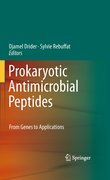
Prokaryotic antimicrobial peptides: from genes to applications
Drider, Djamel
Rebuffat, Sylvie
The book will provide an overview of the advancement of fundamental knowledgeand applications of antimicrobial peptides in biomedical, agricultural, veterinary, food, and cosmetic products. Antimicrobial peptides stand as potentially great alternatives to current antibiotics, and most research in this newly-created area has been published in journals and other periodicals. It is the editors’ opinion that it is timely to sum up the most important achievements in the field and provide the scientific community in a reference book. The goals of this project include illustrating the achievements made so far, debating the state of the art, and drawing new perspectives. Much needed reference of the most important achievements in the filed of antimicrobial peptides. One of the only books written about antimocribial peptides, which are potentially great alternatives to current antibiotics. Chaptershave been contributed by numerous internationally known researchers in the field. INDICE: Part I. Introduction: History, current Knowledge and future research on antimicrobial peptides. Chapter 1. History, current knowledge and futuredirections on bacteriocin research in lactic acid bacteria. Chapter 2. Bacteriocin mediated competitive interactions of bacterial populations and communities. Part II. Classification of prokaryotic antimicrobial peptides. Chapter 3. Classification of Bacteriocins from Gram positive bacteria. Chapter 4. Bacteriocins from Gram negative bacteria: a classification?. Part III. Isolation, purification and production of antimicrobial peptides. Chapter 5. Genomes exploitation and bioinformatics tools. Chapter 6. Design and engineering strategies for synthetic antimicrobial peptides. Chapter 7. Purification techniques of bacteriocins from lactic acid bacteria and other Gram positive bacteria. Chapter 8. Natural and heterologous production of Bacteriocins. Part IV. Genetics, biosynthesis, structure, and mode of action of AMP from gram postive bacteria. Chapter 9. Genetics, biosynthesis, structure and mode of action of lantibiotics.Chapter 10. Class IIa bacteriocins: current knowledge and perspectives. Chapter 11. The two-peptide (Class-IIb) bacteriocins: Genetics, Biosynthesis, Structure, and Mode-of-Action. Chapter 12. Class IIc or circular bacteriocins. Chapter 13. Class IId or linear and non pediocin-like bacteriocins. Part V. Genetics, biosynthesis, structure, and mode of action of AMP from gram negative bacteria. Chapter 14. Colicin killing: foiled cell defense and hijacked cell functions. Chapter 15. Class I microcins: their structure, activities, and mechanisms of resistance. Chapter 16. Class II microcins. Chapter 17. Microcins: on the edge between gram positive bacteriocins and colicins. Part VI. Applications and Perspectives. Chapter 18. Food Applications and Regulation. Chapter 19. Medical and Personal Care Applications of Bacteriocins Produced by Lactic Acid Bacteria. Chapter 20. Perspectives and peptides of the next generation.
- ISBN: 978-1-4419-7691-8
- Editorial: Springer New York
- Encuadernacion: Cartoné
- Páginas: 550
- Fecha Publicación: 29/03/2011
- Nº Volúmenes: 1
- Idioma: Inglés
